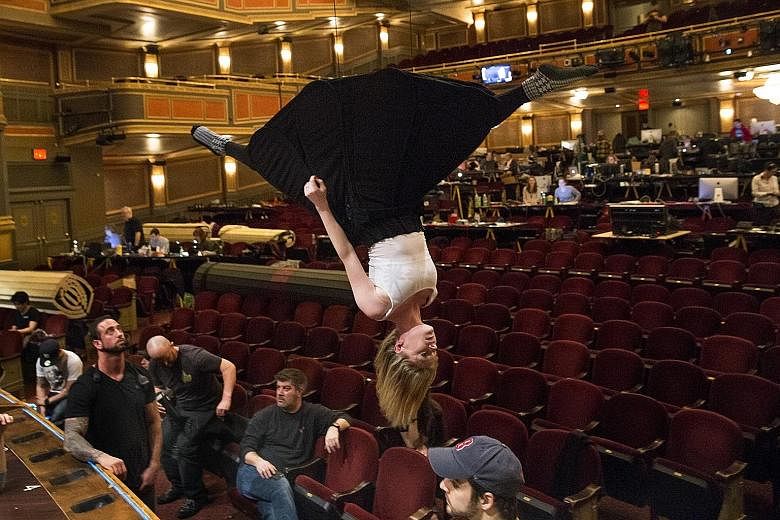NEW YORK • The dancer emerges from stage left, in white tails and top hat; from stage right comes a juggler in a black tuxedo. And then begins a choreographic throwdown - the dancer taps, the juggler balances a cane on his nose - a prelude to the spectacle promised behind the art deco curtain.
The circus is coming to town, but this time with a story to tell.
Cirque du Soleil, a global entertainment behemoth with 17 shows running worldwide, is once again trying to establish a long-running production in New York City, the major league market that has most stubbornly frustrated its ambitions.
A previous Cirque attempt at narrative theatre, Banana Shpeel, disastrously flopped at the Beacon Theater in 2010; a more traditional acrobatic show with multi-year aspirations, Zarkana, quietly faded away after productions at Radio City Music Hall in 2011 and 2012.
So now Cirque is trying a high-wire hybrid - a combination of theatre and acrobatics, with a splash of old Hollywood, in one US$25-million (S$34-million) musical called Paramour. And, never one to bet small, it is opening the show cold on the world's most famous stage: Broadway.
The timing is, to put it mildly, challenging. The company, long dominated by its storied founder, the fire-eater-turned-billionaire Guy Laliberte, just last year was acquired by a group of investors, led by the private equity firm TPG, that is closely watching costs as it seeks revenue growth.
And Broadway, always home to more flops than hits, is particularly competitive this year - there are currently 36 plays and musicals, many with strong reviews and crowd-pleasing titles or stars, vying for audiences before Paramour's previews began last Saturday at the Lyric Theater in anticipation of an official opening on May 25.
Cirque arrives on Broadway with enviable strengths: a well-known brand, world-class acrobatic performers, considerable marketing muscle and deep enough pockets to let a show build. And the company, explicitly pitching its show to domestic and international tourists, is opening after this year's Tony Awards eligibility deadline - meaning it would not be hurt or helped by the spring awards cycle - and on the eve of summer, when out-of- town visitorship is especially high.
"The people that work there are really smart artists, but how are they going to make their next step?," said Ms Diane Paulus, a theatre director represented on Broadway this season with Waitress. In 2012, she directed a big tent show, Amaluna, for Cirque, and in 2013 won a Tony Award for Pippin, which was noteworthy for its successful integration of circus arts with dance.
"It is a big question mark for Cirque. What's next for them and how are they going to break new ground after they broke ground so powerfully 35 years ago?" she said.
Paramour is expensive by Broadway standards - at US$25 million, it costs twice as much to mount as musical Hamilton - but not for Cirque, which once spent US$165 million developing a single show, Ka, in Las Vegas.
"Obviously, we want to be successful in New York because it is such a large market and such a large tourist destination, but this is not even close to a bet-the-company type of thing,"said Mr David Trujillo, the TPG partner who is managing that company's Cirque investment. "This is one show."
Paramour is distinguished from most other Cirque productions by the use of a script with dialogue, original songs (10 of them, composed by the frequent Cirque collaborators Bob & Bill, along with Andreas Carlsson, and played by an eight-piece band) and a fully realised story (a love triangle, set in Hollywood's Golden Age, involving a film director, his muse-like star and a composer).
But it also has plenty to appeal to diehard Cirque fans: contortionists, jugglers, trapeze artists and tumblers; trampolines and teeterboards; banquine (human pyramids) and hand to hand (partner acrobatics on the floor) and hand to trapeze (a woman travels between a male porter on the ground and one on a trapeze, representing the love triangle).
The show will make heavy use of technology - it includes video projections and eight costumed drones - and, in an attempt to mimic the circus, will break the fourth wall with a strap act above showgoers, a chase scene through the theatre and rappelling into the audience.
The cast is big for Broadway (small for Cirque), with 22 acrobats and 16 actors. It is multinational and multilingual, with performers from 13 countries. It includes a pair of identical twins (aerial strap artists Andrew and Kevin Atherton), a married couple (trapeze performers Sam Charlton and Myriam Deraiche) and 10 alumni of national gymnastics or acrobatics teams.
The company also hopes to bring to Broadway a stage version of the live broadcast of The Wiz that it developed with NBC last year.
"We know how brutal Broadway can be, but I think we have the right ingredients to sustain the position here, serving the Broadway audience and the Cirque family at the same time," said a bullish Mr Daniel Lamarre, the company's president and chief executive.
NEW YORK TIMES

